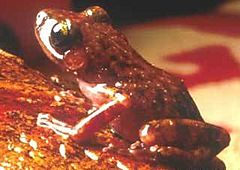Leptodactylidae facts for kids
Quick facts for kids Leptodactylidae |
|
|---|---|
 |
|
| Eleutherodactylus guttilatus | |
| Scientific classification | |
| Kingdom: | |
| Phylum: | |
| Class: | |
| Subclass: | |
| Order: | |
| Suborder: | |
| Superfamily: |
Hyloidea
|
| Family: |
Leptodactylidae
Werner, 1896
|
| Subfamilies | |
|
|
 |
|
| Distribution of Leptodactylidae (in black) | |
Leptodactylidae is a family of frogs. They are believed to have been on Earth since the Cenozoic era or at the end of the Mesozoic. There are 1,100 species in 50 genera. The Eleutherodactylus is the largest genus with over 700 different species. Leptodactylidae frogs lives in Mexico, the Caribbean, and Central and South America. The family includes terrestrial, burrowing, aquatic, and arboreal frogs.
Some of the frogs lay their eggs in foam nests. They will lay their eggs in crevices, on the surface of water, or on the forest floors. For tadpoles that are laid on the forest floors will remain there until they become frogs. They will not eat anything. In the genus Elutherodactylus, the eggs will automatically become small frogs. They will not go through the tadpole stage. Leptodactylids can be found in fossil records. One specimen, was found preserved and is thought to be 37 million years old.
See also
 In Spanish: Leptodactílidos para niños
In Spanish: Leptodactílidos para niños

